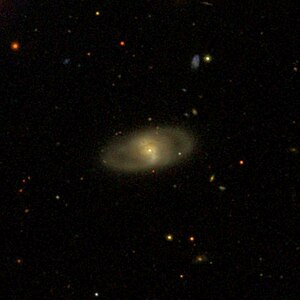NGC 2860
| Galaxy NGC 2860 |
|
|---|---|

|
|
| SDSS | |
| AladinLite | |
| Constellation | lynx |
|
Position equinox : J2000.0 , epoch : J2000.0 |
|
| Right ascension | 09 h 24 m 53.2 s |
| declination | + 41 ° 03 ′ 37 ″ |
| Appearance | |
| Morphological type | SBa / HII |
| Brightness (visual) | 13.7 mag |
| Brightness (B-band) | 14.6 mag |
| Angular expansion | 1.5 ′ × 0.6 ′ |
| Position angle | 108 ° |
| Surface brightness | 13.4 mag / arcmin² |
| Physical data | |
| Redshift | 0.014112 ± 0.000061 |
| Radial velocity | 4231 ± 18 km / s |
|
Stroke distance v rad / H 0 |
(189 ± 13) · 10 6 ly (57.9 ± 4.1) Mpc |
| history | |
| discovery | Édouard Stephan |
| Discovery date | March 17, 1884 |
| Catalog names | |
| NGC 2860 • UGC 5007 • PGC 26685 • CGCG 209-065 • 210-005 • MCG + 07-20-003 • IRAS 09216 + 4116 • 2MASX J09245319 + 4103366 • | |
NGC 2860 is a bar-spiral galaxy with extensive star formation regions of the Hubble type SBa in the constellation Lynx in the northern sky . It is an estimated 189 million light years away from the Milky Way and has a diameter of about 80,000 ly.
In the same area of the sky are the galaxies NGC 2852 and NGC 2853 .
The object was discovered by Édouard Stephan on March 17, 1884 .
